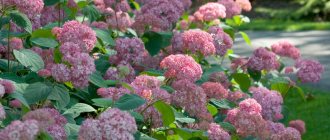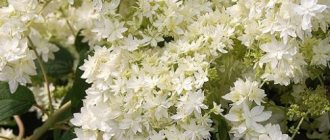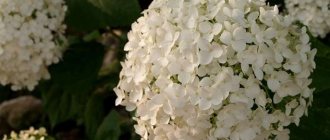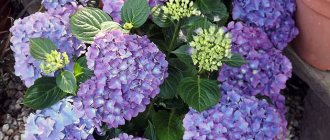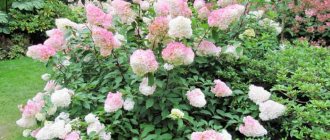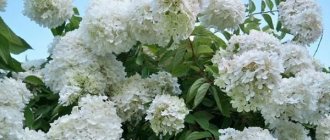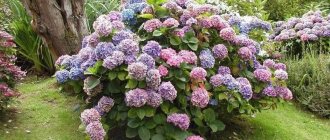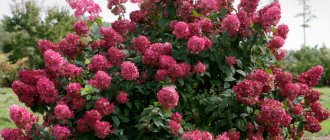The first Hydrangea arborescens (a North American species) was brought to England around 1736 from Pennsylvania by Peter Collison. Grovonius gave the plant its first name in 1739 in his work Flora Virginica: Hydrangea. The botanist Carolus Linnaeus, to whom our current system of plant names (binomial nomenclature) is indebted, was described as Hydrangea tree in 1753.
Wild hydrangea tree grows in North America, Southeast and South Asia, including China, Japan, Indonesia and the Himalayas. Wild hydrangea can be found in southern Illinois, is rare in central Illinois, and is almost absent in the northern part of the state. Habitats include shaded gorges, rocky riverbanks in wooded areas, cliff and rock bottoms, and low rocky outcroppings.
Tree hydrangea is a shrub 100-250 cm high. The shoots are straight woody with gray or brown bark, young ones are light green, sometimes pubescent. With age, the bark breaks into colorful shreds, giving it a shabby appearance. Pairs of opposite leaves grow at intervals along each shoot. The leaves are approximately 10-15 cm long and 7-13 cm wide, oval-ovate or oval-cordate, serrated along the edges. The upper part of each leaf is light green to dark green, not pubescent, the lower part of the leaf is pale green, not or sparsely pubescent. Petioles are 5-15 cm long, not pubescent or pubescent.
Each shoot ends in a flat panicle of flowers approximately 7-15 cm wide. The center of the panicle consists of numerous fertile small flowers; around the outer edge of the panicle there are larger sterile ones (2 cm wide). Sterile flowers are absent from some wild plant populations. Each fertile flower has a short light green calyx with slight teeth, 5 tiny white petals less than 3 mm long, 8 or 10 long filament stamens and a pistil, and the flowers are greenish-white or cream. Each sterile flower has 3-4 large petals and bracts. The branches of the panicle have a dull cream color and are usually pubescent. Flowering occurs in early to mid-summer. Fruiting flowers quickly fade, create a small 2-chambered capsule with seeds approximately 3 mm wide, sterile remain attractive until autumn. The sides of the capsule are ribbed. Each capsule contains tiny, flattened seeds.
‹ Left Right ›
Description
Tree hydrangea (Hydrangéa arboréscens) belongs to the Hydrangeaceae family. North America is considered the birthplace of the plant. The natural habitat is the rocky mountains and river banks of Indiana, New York, and Oklahoma. Found naturally in China and India. Hydrangea was brought to Europe at the beginning of the 19th century by the German naturalist Philip Franz von Siebold. The cultivated shrub can now be seen in any country in the world.
Experts use another botanical name for the plant - hydrangia, which is translated from Greek as “a vessel with water”. And this is no coincidence, since the shrub is quite moisture-loving. In Japan, the culture is called “longing for water”; in eastern countries it is called “fashionista”: due to the changing shades of colors (white, greenish, pink). In the language of flowers, hydrangea means “remember me.” She was assigned such qualities as sincerity, hope, modesty.
The deciduous shrub reaches an average height of 1.5 meters, in nature – up to 3 meters. Thin tubular shoots are slightly pubescent. The voluminous, ovoid leaves have a rich green color that lasts until cold weather. In some species, shoots acquire a reddish tint by August. The length of the leaf blades is about 20 cm. The leaves on thin, long petioles are located on the branches opposite each other (opposite).
Hydrangea blooms profusely and luxuriantly from June to October. Large caps of inflorescences, reaching a diameter of 15-30 cm, consist of many flowers, which are smaller in the center than at the edges. The maximum diameter of one bud is 3 cm. Depending on the variety, the color of the petals may vary. Densely arranged inflorescences often cover the bush completely, as if a cloud had landed. By the end of October, seeds ripen on the plant.
Tree hydrangea is quite cold-resistant. It grows quickly: shoots grow thirty centimeters per season.
There are many legends and beliefs associated with the plant. One of them says that on Buddha’s birthday, flowers rained from the sky, and then a wonderful nectar called “amicha” poured down. Suddenly, a flowering shrub called “aujisai” appeared, which is what the Japanese call hydrangea.
Another Japanese legend says that a guilty emperor gave his beloved’s family a bouquet of hydrangeas to make amends. Since then, the flower has symbolized the sincerity of feelings. Although in some countries, a gift of hydrangea means love suffering and loneliness.
If we talk about signs, then an ornamental shrub growing in a garden plot will keep the owner from doing bad things and help overcome bad habits: alcohol, smoking; will give peace of mind and good health.
Story
As scientists have proven, tree hydrangea is one of the most ancient plant species that existed in the northern hemisphere forty or more million years ago, when dinosaurs inhabited the planet.
But it was discovered as an ornamental plant much later, at the beginning of the eighteenth century, when the great botanist John Bartram, on one of his expedition trips to North America, discovered this flower, amazing in its unobtrusive, simple beauty.
Then came years, decades of careful selection and improvement of the variety. As a result, by the twenty-first century, gardeners received the widest selection of hydrangeas , in which every person will find something to their taste, according to growing conditions, according to their characteristic features. But we’ll talk about hydrangea varieties a little later, and now about the rules of cultivation.
Types and varieties
At the beginning of the twentieth century, the selection of tree hydrangea began. Today, breeders have bred about 70 varieties of the plant. Scientists continue to work on obtaining new unusual shades, double flowers and original leaf shapes. Now there are more than a hundred varieties of hydrangea. Winter-hardy varieties are popular, making it possible to grow ornamental shrubs in the Moscow region and Russian regions with a cold, changeable climate.
Annabelle
The popular variety attracts the eye with large snow-white inflorescences, the diameter of which is about 20 cm. Under the weight of the inflorescences, the branches can bend towards the ground. Long flowering: June – September.
An adult shrub reaches 1.5 meters in height and grows up to 3 meters in width. The color of the leaves lasts until autumn. The Annabelle variety tolerates severe frosts (down to -40-50 degrees) and is suitable for growing in unfavorable climatic regions. It is more difficult for a plant to survive drought than cold, so hydrangea needs regular and timely watering. In one place, this garden crop can grow for 40-50 years, continuing to delight every year with magnificent “caps” of white flowers. The shade of the buds can be changed by watering the plant with a special solution.
Grandiflora
Hydrangea of this variety is recommended to be grown in regions with milder climates, since the root system is not as resistant to extremely low temperatures as that of Annabelle. The plant grows quickly, shoot growth reaches 25 cm per year. The size of an adult bush ranges from 1.5 to 2 meters in height, and grows no more than 3 meters in width.
Large leaves of bright green color. Umbrella inflorescences change color several times during flowering: the blooming flowers of a soft green hue acquire a snow-white color. Towards the end of flowering they become creamy and yellow in color. The flowering period is long - from June to September.
The variety is resistant to drought and pests. In rainy weather, watering should be avoided to avoid fungal infections.
Sterilis
Hydrangea is characterized by rapid growth, reaching a maximum height of about 2 m, width - 2.5 m. Flowering lasts 4 months, starting in June. The greenish-tinged flower petals become snow-white as they bloom. The heart-shaped leaves are 15 cm long. The plant is resistant to temperature changes and needs shelter for the winter. Does not like to grow in windy areas.
Pink Annabelle
The variety was bred on the basis of "Annabelle". The peculiarity of the tree-like shrub is the flowers are dark pink in color. Lush inflorescences look like a pyramid, reach a diameter of 30 cm. Elastic shoots are resistant to strong winds and heavy rains, and do not bend under the weight of flowers. The oval green leaves have a glossy shine, turn yellow and fall off in the fall.
Incrediball
This variety of hydrangea is distinguished by the large size of its inflorescences, the diameter of which reaches 30 cm. The branches of the plant are erect and powerful. They easily hold heavy inflorescences. The color of the petals changes from soft green to snow-white. The average height of an adult shrub is 1.5 meters. Bad weather is not scary for hydrangea: it easily tolerates drought and frost, precipitation and wind, and every year continues to surprise with its abundant flowering.
Sweet Annabel
The height and width of the shrub reaches 1.2 m. Red-pink inflorescences bloom on strong shoots in June. During long flowering, the color of the petals becomes pale, and by autumn it acquires a greenish tint.
Hayes Starburst
The dome-shaped inflorescences of hydrangea consist of many double white star flowers. The variety has a long flowering period: from June until frost. The bright green leaves retain their shade until autumn. The shrub does not exceed a height of 1.2 meters. Strong branches can withstand the load during flowering and do not bend.
Reviews
The variety Invisible surprised us with its vitality! Only planted in the ground, after an unsuccessful winter in a container, it began to increase its green mass and is already pleasing the home with flowers. Absolutely not demanding. Only abundant watering and shading. Beauty, I can't stop looking at it. This is what she will be like in two years!
Julia
Annabelle is a huge bush. Several years ago it was dug up from an old plant from neighbors in the country. It looked like a tree, not a bush. The height is under 3 m, I would never have believed it if I had not seen it myself. I limit the growth of my bush by pruning. Flowers in huge caps - in two of my palms. Reminds me of summer clouds. Flowering lasts for a long time, almost a month! I love it very much.
Natalia
Features of cultivation and care
Before growing tree hydrangea, you need to familiarize yourself with the features of caring for the plant. By following the simple rules of agricultural technology, the ornamental shrub will delight you with abundant flowering every year.
Soil selection
It is not recommended to plant hydrangea in alkaline soil. The shrub will grow well on slightly acidic and acidic loams. A small amount of lime will not harm the plant. You can acidify the soil substrate using sawdust, peat and pine bark. This must be done 6 months before planting the crop.
Location and lighting
Ornamental shrubs should be planted immediately in a permanent place, since frequent transplants are not recommended. Hydrangea takes a long time to adapt to a new area.
Experts advise when choosing a location to consider the following features:
- abundant, diffuse lighting. The scorching rays of the sun should be avoided. Otherwise, the petals of the inflorescences will lose their original color - they will “burn out”, and the flowering period of the hydrangea will decrease by 3-5 weeks. It is also better not to plant in the shade. With a lack of sunlight, the inflorescences and petals become smaller;
- protection from wind and draft. When there are gusts of wind, shoots with heavy inflorescences may bend towards the ground, which will change the shape of the bush: it will not look so attractive;
- sufficient area for growth. The distance from neighboring shrubs and trees should not be less than two meters so that they do not shade the hydrangea and take moisture from the soil.
Hydrangeas will grow comfortably near various garden fences. In the first half of the day, the plant will receive abundant lighting; from lunchtime, the fence will protect it from the scorching rays of the sun. In addition, such a place looks impressive from the point of view of landscape design.
Temperature, humidity, watering
Proper watering of tree hydrangea is one of the important rules in caring for shrubs. If there is a lack of moisture, the plant can “throw off” its inflorescences; if there is too much, it can cause rotting of the root system.
Watering should be carried out depending on the weather: when dry - 1 or 2 times a week, when rainy - exclude during precipitation. Hydrangea should be watered with soft, settled water, the temperature of which should not be lower than +20 degrees.
Fertilizers and fertilizers
It is recommended to feed hydrangea in several stages:
- The first feeding is carried out 2 weeks after planting. Feed with the following composition: urea (20 g), potassium (30 g), superphosphate (40 g). This mixture is added annually in early spring;
- the second feeding is carried out before flowering. You can use ready-made Kemira-flower fertilizer, or you can independently prepare a mixture of superphosphate and potassium in proportions of 50:40. You should not add a lot of nitrogen, otherwise the flower petals will turn greenish;
- The final feeding at the end of summer will be the application of rotted manure: 15 kg per 1 sq.m.
Fertilizers cannot be applied in the fall, since the branches need to have time to become woody by winter.
To strengthen the branches, you can water the bush with a weak manganese solution.
Transfer
Hydrangea is replanted in spring or autumn. Replanting should not be done during the summer months. During flowering, it is difficult for the plant to adapt to a new place. The inflorescences will fall off and may not appear again even next year.
The most favorable time for transplantation is spring. It is important to carry out this procedure before the buds open.
In autumn, the shrub is replanted after flowering; it is advisable to do this at the end of September. Hydrangea will have time to “get comfortable” in the new place before the onset of frost and spend the winter safely.
Transplant rules:
- dig up a bush with a lump of earth, trying not to damage the roots;
- before or after planting, hydrangea is pruned, shortening the shoots by a third of the length;
- the transplanted hydrangea is watered abundantly;
- within 2-3 weeks after transplantation, the shrub needs to be shaded from the bright rays of the sun;
- fertilizing is carried out after a month, when active growth of shoots begins. This means that the hydrangea has successfully taken root.
Preparing for winter and caring for winter
Varietal hydrangea has good winter hardiness, which allows it to be grown in regions with harsh climates. Even if the plant is damaged by frost, it grows back and blooms.
Faded inflorescences and new shoots must be removed in the fall: young shoots may not tolerate frost. Experienced gardeners, wanting to grow a short bush, often cut off all the branches, leaving 2-3 buds on each. In spring new shoots appear. Hydrangea is thus rejuvenated.
Annual and biennial plants need shelter for the winter. Covering material or spruce branches will protect the hydrangea from frost. You can build a wooden fence around the bush, which will trap snow.
It is advisable to hill up a mature shrub well for the winter and sprinkle the soil around the leaves with yellowed leaves to protect the roots from frost.
Planting tree hydrangea
Selecting a location
In areas with a warm climate, it is better to choose a place for planting tree hydrangea in partial shade. It grows well in the sun, but it requires regular and abundant watering. In the middle zone and to the north, areas with good lighting or openwork shade are more suitable for this crop.
Landing dates
This type of hydrangea is planted in the southern part of Russia in spring and autumn, and in more northern areas it is recommended to plant only in spring.
Landing technology
- The width, length and depth of the hole varies from 30 to 40 cm depending on the size of the ball of earth with roots (container plants) or the root system (seedlings with OCS).
- Since tree hydrangea is demanding on the presence of moisture and nutrients, it is advisable to fill the holes during planting with a mixture of river sand, leaf humus, compost or turf soil.
- When planting a plant, the root collar (the place where the branches end and the roots begin) is placed at ground level and care is taken that it is not covered with soil.
- Before planting, check the roots and cut off any broken, very dried out or excessively long roots. The bulk of the roots should be approximately the same length. If container plants are planted, very tangled roots are also straightened and trimmed a little.
- To speed up survival, the roots are soaked in a heteroauxin solution for several hours (from 2 to 24), and then immediately planted.
- After planting, the plants are watered with plenty of water and the settled soil is added.
| Even slight drying of the roots leads to difficulties during rooting, and also negatively affects the further growth and development of the bush. Newly planted bushes need to be protected from strong sun and strong air currents for several weeks. |
Pruning in spring
Tree hydrangeas are pruned in the spring before the buds open.
The procedure has three goals:
- rejuvenating: branches are left no higher than half a meter from the ground. Such a plant will bloom only next year;
- formative: to give a decorative appearance to the shrub. So that the plant does not thicken and the flowering is abundant, strong shoots are shortened by 3-5 buds, weak shoots are reduced by 2 buds. After this type of pruning, the hydrangea must be fed with nitrogen, potassium and phosphorus;
- sanitary: remove broken, dried, undeveloped shoots after winter.
Young tree-like hydrangeas are not pruned until they are four years old.
Reproduction methods
Hydrangea can be propagated in three ways.
Green cuttings
Cuttings are cut in early June with 2-3 pairs of leaves. Half of the leaf blade is cut off. Cut shoots are placed in a root growth stimulator for 5 minutes. The cuttings are planted in a greenhouse or in a bed with light nutritious soil. They shade. The lower paired buds are deepened into the soil to the middle of the internode.
After 20-30 days, the cuttings will take root. Throughout this period, it is necessary to maintain high humidity by covering the cutting with a cut plastic bottle.
By layering
In spring, the shoot is carefully bent to the soil, placed in a shallow groove, sprinkled with a 2 cm thick layer of soil substrate, and pinned. There is no need to sprinkle the tip of the shoot; bend it slightly upward.
The soil must be kept moist throughout the season. In summer and autumn the soil needs to be topped up. Next spring, the rooted shoot is separated from the adult bush with pruning shears. It is planted in fertile soil in a shaded area for growing.
Tree hydrangea grown from layering or cuttings can be planted in a permanent place after a year or two. The young shrub will bloom in the 4th year.
Dividing the bush
Hydrangea is dug up and divided using pruning shears or a sharp shovel. New parts of the plant are planted in a hole that is prepared in advance. Then the branches are cut off. The divided hydrangea takes root well.
Landscaping Tips
This ornamental shrub can be combined with many types of crops. Here you should take into account both the location of the flower garden and the characteristics of the site.
In sunny places, together with tree hydrangea, spirea, mock orange, and lilac will feel great. Hydrangea looks very harmonious near a pond, filling the space and becoming the main compositional element. Together with it, hosta and astilbe will take root near the water and complement the appearance.
Hydrangea in landscape design
You don’t have to be afraid to plant this species near fruit trees. A fruit tree will not harm the ornamental shrub in any way, but the second one will only add volume and attractiveness to the entire garden.
Tree hydrangea is an amazing and incredibly attractive shrub that can enliven any area with its appearance.
0 0 votes
Article rating
Possible problems
The hydrangea has wilted: the plant lacks moisture. This may also happen due to excessively high air temperatures.
The leaves have turned yellow: old leaf blades turn yellow due to waterlogging, young ones - due to excessively hard irrigation water. Watering should be done with moderately soft water, depending on the weather.
The color of the inflorescences has changed: this means that the acidity of the soil has changed.
The flowers have faded: one of the reasons is that the hydrangea is constantly exposed to direct sunlight. The shrub needs to be shaded at noon.
Slow growth, poor flowering: the wrong place for growing. The plant is in the shade all day and lacks sunlight.
Diseases and pests
Proper care is the key to healthy hydrangea. High humidity and low temperatures can cause fungal infections that affect leaves and flowers. Such diseases include powdery mildew, septoria, rust, downy mildew, gray and white rot. For preventive purposes, it is recommended to treat hydrangea tree with Bordeaux mixture. A diseased plant is treated with specialized fungicidal agents.
Sometimes hydrangea is affected by insect pests: aphids, slugs, spider mites, nematodes. With a small lesion, you can try to destroy the parasites using folk remedies. To do this, prepare a garlic or tobacco solution (100 g per 5 liters of water), leave it for 2 days. Before spraying, add a small amount of soap to the solution so that the infusion adheres well to the leaves.
In case of significant damage, you will have to use the appropriate insecticides - “Aktellik”, “Aktara”, “Fitoverm” and others.

